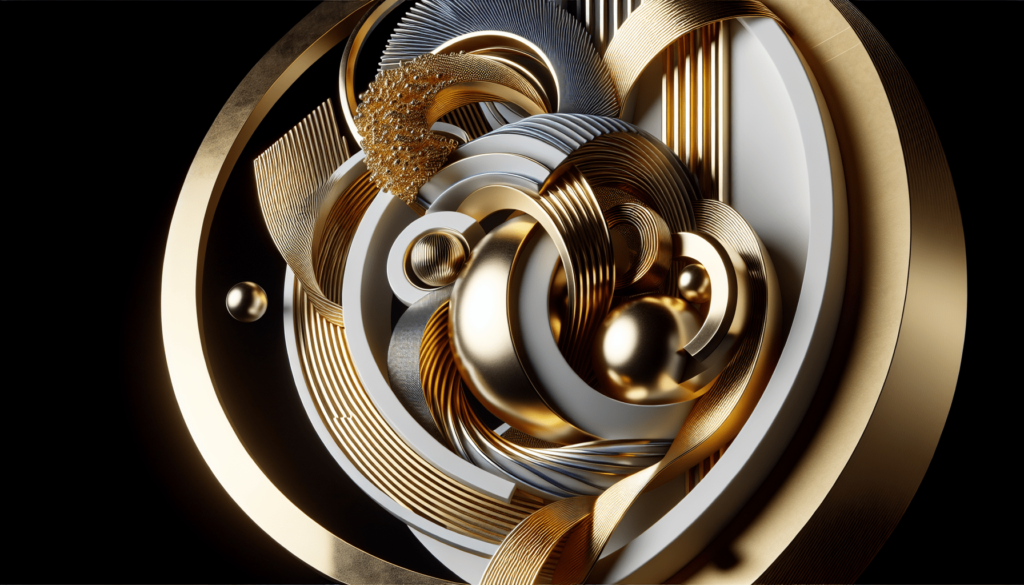Have you ever wondered about the connection between gold and contemporary art movements? How has gold been used throughout history, and how is it integrated into modern art practices? Keep reading to explore the fascinating intersection of gold and contemporary art movements.

The Significance of Gold in Art History
Gold has been a symbol of wealth, power, and prestige throughout history, and its use in art dates back to ancient civilizations such as the Egyptians, Greeks, and Romans. From ornate jewelry to religious artifacts, gold has been valued for its brilliance and permanence in artistic expressions. Its association with the divine and royalty has elevated gold to a status of utmost importance in artistic practices.
Gold in Ancient Civilizations
In civilizations such as ancient Egypt, gold was considered the skin of the gods and was extensively used in funerary objects and religious artifacts. The Egyptians believed that gold had magical properties and reflected the radiance of the sun god Ra. The Greeks and Romans also valued gold for its lustrous beauty and association with immortality.
Gold in Contemporary Art Movements
Contemporary artists have continued to explore the use of gold in their work, redefining its meaning and significance in the context of modern society. Contemporary art movements such as Pop Art, Minimalism, and Conceptual Art have all incorporated gold in innovative ways, challenging traditional notions of value and materiality.
Pop Art and Gold
Pop artists such as Andy Warhol and Jeff Koons have used gold as a symbol of consumer culture and mass production. Warhol’s iconic “Gold Marilyn Monroe” series and Koons’ balloon animals coated in gold challenge the viewer to reevaluate the relationship between art, commerce, and luxury.
Minimalism and Gold
Minimalist artists like Donald Judd and Dan Flavin have utilized gold in their work to create an aura of purity and transcendence. The use of gold in minimalist art emphasizes the materiality of the object while elevating it to a state of contemplation and meditation.
Conceptual Art and Gold
Conceptual artists such as Yves Klein and Damien Hirst have explored the conceptual and symbolic meanings of gold in their work. Klein’s famous “Monochrome Gold” paintings and Hirst’s sculptures encrusted with gold challenge the viewer to question the value and significance of the material itself.

The Use of Gold Leaf in Art
One of the most common ways that artists incorporate gold into their work is through the use of gold leaf. Gold leaf is a thin sheet of gold that is applied to a surface using adhesive, creating a luminous and reflective effect that has captivated artists for centuries. The process of applying gold leaf requires skill and precision, as the delicate nature of the material demands careful handling.
Techniques for Applying Gold Leaf
There are various techniques for applying gold leaf, including water gilding, oil gilding, and size gilding. Water gilding involves applying a thin layer of water-based adhesive to the surface before laying the gold leaf down. Oil gilding uses an oil-based adhesive, while size gilding uses a specialized type of glue known as “size” to adhere the gold leaf.
Contemporary Artists Using Gold Leaf
Contemporary artists such as Olafur Eliasson and Anish Kapoor have incorporated gold leaf into their work to create mesmerizing and immersive experiences for the viewer. Eliasson’s reflective installations and Kapoor’s polished sculptures both utilize gold leaf to enhance the luminosity and depth of their respective works.
Gold as a Symbol of Status and Wealth
Throughout history, gold has been synonymous with status, wealth, and power. Its scarcity and brilliance have made it a coveted material that signifies luxury and prestige. In art, the use of gold has often been a way for artists to communicate social commentary on wealth disparities and the commodification of art.
Critiques of the Use of Gold in Art
Some contemporary artists have critiqued the use of gold in art as a symbol of excess and opulence. By incorporating gold into their work, artists like Banksy and Ai Weiwei challenge the viewer to confront issues of wealth inequality and the commercialization of the art world.
Gold as a Cultural Symbol
Gold has also been used as a cultural symbol in art, representing purity, divinity, and enlightenment. In religious art, gold is often associated with the divine and is used to depict saints, angels, and other spiritual figures. Artists such as Gustav Klimt and Kehinde Wiley have used gold as a symbol of empowerment and cultural heritage in their depictions of marginalized communities.
The Future of Gold in Contemporary Art
As contemporary art continues to evolve and expand, the use of gold in artistic practices is likely to remain a relevant and meaningful element. Artists will continue to experiment with gold as a material, exploring its symbolic, aesthetic, and conceptual possibilities in innovative ways.
Sustainability and Ethics in Gold Mining
One of the key challenges facing the use of gold in art is the environmental and ethical implications of gold mining. Artists and art institutions are increasingly mindful of sourcing gold from sustainable and ethical mines, ensuring that their work does not contribute to environmental degradation or human rights abuses.
Technological Innovations in Gold Art
Advancements in technology have also expanded the possibilities for using gold in art. From 3D printing to digital projection mapping, artists are finding new ways to integrate gold into their work using cutting-edge techniques and materials. The intersection of gold and technology offers exciting opportunities for artists to push the boundaries of what is possible in contemporary art.
Conclusion
In conclusion, the intersection of gold and contemporary art movements offers a rich and complex landscape for artists to explore. From its historical significance as a symbol of wealth and power to its contemporary interpretations in art, gold continues to captivate and inspire artists across cultures and time periods. As artists continue to push the boundaries of artistic expression, the use of gold in art is likely to remain a dynamic and enduring element in the ever-evolving world of contemporary art.

